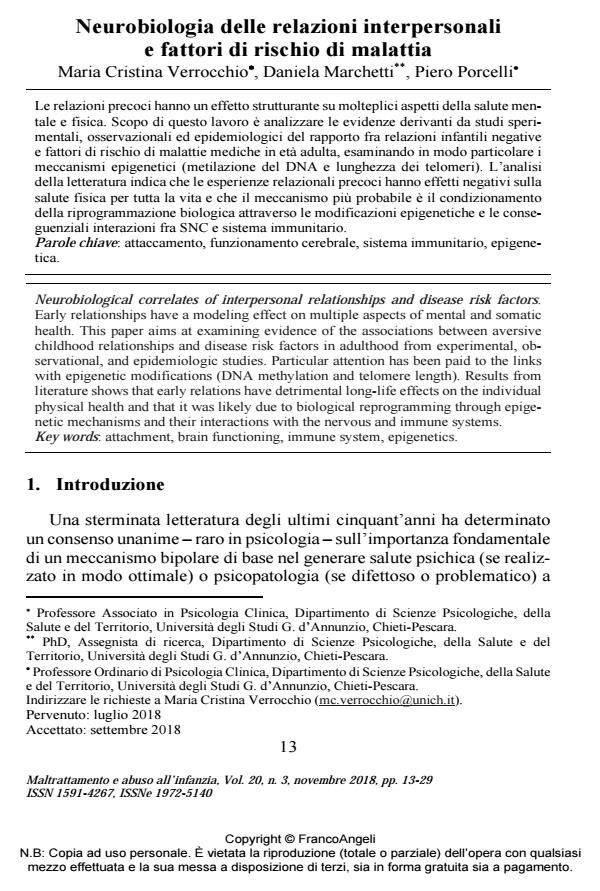Neurobiologia delle relazioni interpersonali fattori di rischio di malattia
Titolo Rivista MALTRATTAMENTO E ABUSO ALL’INFANZIA
Autori/Curatori Maria Cristina Verrocchio, Daniela Marchetti, Piero Porcelli
Anno di pubblicazione 2018 Fascicolo 2018/3
Lingua Italiano Numero pagine 18 P. 13-30 Dimensione file 245 KB
DOI 10.3280/MAL2018-003002
Il DOI è il codice a barre della proprietà intellettuale: per saperne di più
clicca qui
Qui sotto puoi vedere in anteprima la prima pagina di questo articolo.
Se questo articolo ti interessa, lo puoi acquistare (e scaricare in formato pdf) seguendo le facili indicazioni per acquistare il download credit. Acquista Download Credits per scaricare questo Articolo in formato PDF

FrancoAngeli è membro della Publishers International Linking Association, Inc (PILA)associazione indipendente e non profit per facilitare (attraverso i servizi tecnologici implementati da CrossRef.org) l’accesso degli studiosi ai contenuti digitali nelle pubblicazioni professionali e scientifiche
Le relazioni precoci hanno un effetto strutturante su molteplici aspetti della salute mentale e fisica. Scopo di questo lavoro è analizzare le evidenze derivanti da studi sperimentali, osservazionali ed epidemiologici del rapporto fra relazioni infantili negative e fattori di rischio di malattie mediche in età adulta, esaminando in modo particolare i meccanismi epigenetici (metilazione del DNA e lunghezza dei telomeri). L’analisi della letteratura indica che le esperienze relazionali precoci hanno effetti negativi sulla salute fisica per tutta la vita e che il meccanismo più probabile è il condizionamento della riprogrammazione biologica attraverso le modificazioni epigenetiche e le conseguenziali interazioni fra SNC e sistema immunitario.
Parole chiave:Attaccamento, funzionamento cerebrale, sistema immunitario, epigenetica.
- Fybromialgia, interoception and risk factor for emotional dysregulation: A single case pilot study Michela Balconi, Laura Angioletti, in MALTRATTAMENTO E ABUSO ALL'INFANZIA 1/2020 pp.25
DOI: 10.3280/MAL2020-001003 - The Effect of Parent Psychological Distress on Child Hyperactivity/Inattention During the COVID-19 Lockdown: Testing the Mediation of Parent Verbal Hostility and Child Emotional Symptoms Daniela Marchetti, Lilybeth Fontanesi, Serena Di Giandomenico, Cristina Mazza, Paolo Roma, Maria Cristina Verrocchio, in Frontiers in Psychology 567052/2020
DOI: 10.3389/fpsyg.2020.567052 - Problematiche psicologiche e disturbi da stress post-traumatico in studenti universitari italiani durante il primo lockdown da Covid-19 e terapia EMDR online Giulia Savarese, Daniela D’Elia, Nadia Pecoraro, Lugi Curcio, Oreste Fasano, Monica Mollo, in MALTRATTAMENTO E ABUSO ALL'INFANZIA 2/2021 pp.63
DOI: 10.3280/MAL2021-002005
Maria Cristina Verrocchio, Daniela Marchetti, Piero Porcelli, Neurobiologia delle relazioni interpersonali fattori di rischio di malattia in "MALTRATTAMENTO E ABUSO ALL’INFANZIA" 3/2018, pp 13-30, DOI: 10.3280/MAL2018-003002